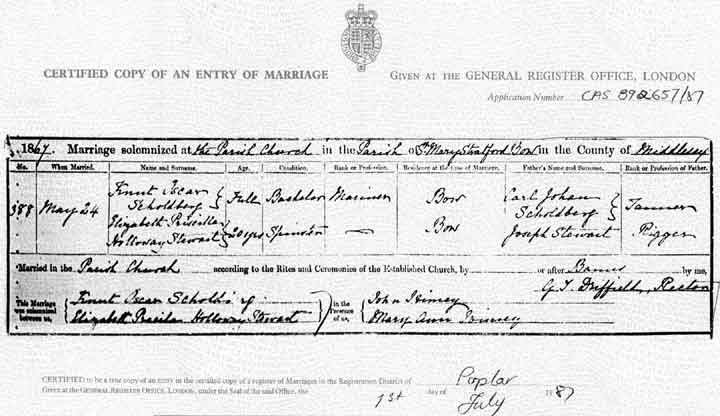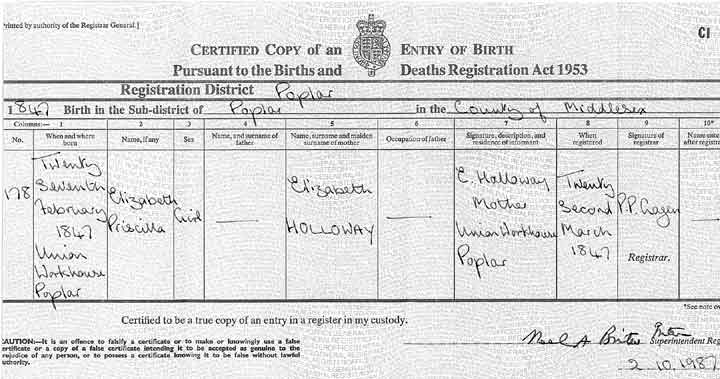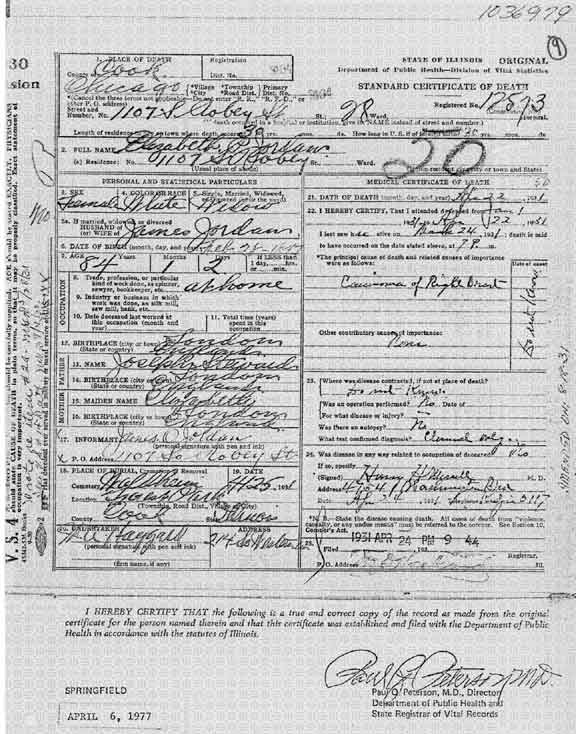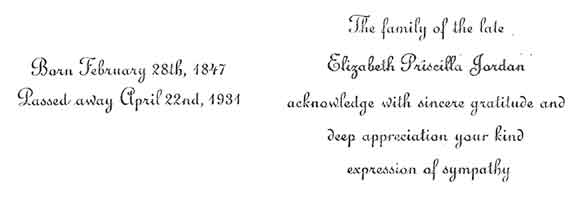- Through a researcher, the above record was obtained from microfilm 246,509 in the LDS Family History Center. Another film 472,740 appears to cover additional records for the Poplar Union Workhouse, such as burials from 1837-1889, admissions and discharges from 1845-1871 and creed registers from 1848-1900. Additional information may be obtained someday for Elizabeth Holloway from the admission and discharge records. However, the index for Poplar Union Workhouse should be searched first rather than relying on these microfilm numbers.
- The record indicates Elizabeth was born February 27, 1847.
- The image above shows a list of births at the Poplar Union Workhouse from December 1846 to March 1847. Only Elizabeth Holloway's has been extracted. In the extraction, repeat marks were not used but instead the entry from higher in the listing was inserted to make the result more readable.
- The small writing on the record is mine for clarification.
- In the column "Name of Parents" only Elizabeth Holloway is shown. Given the other entries for illegitimate births, it seems common that only the mother is listed. Thus one could interpret that she knew the father but it was uncommon to write it down.
- In the column "When Baptized" there is no indication for Elizabeth Priscilla. However there is no indication for the entries after Elizabeth Priscilla either. The word on the very top row is "Register" and the repeat marks end one person above Elizabeth Priscilla. It is possible that Elizabeth was baptized since there is an entry for "In what Name Baptized". There may be a register somewhere with the baptismal information in it.
- The Poplar Workhouse was located on the south side of High Street and a few blocks east of Wade Street. Thus the Workhouse was within a mile of most known residences of the Stewards.
- To better understand what a workhouse was, information was requested from the Bancroft Library in Tower Hamlets. An 1866 official inquiry into the Poplar Workhouse was available and was obtained. From this report it appears that the workhouse is more of a hospital than a workhouse at least in 1866. The workhouse in 1866 was old, not too clean, and served to provide for the old, the poor, the sick, the in-firm, those with contagious diseases and mother's with illegitimate children. In a way, it has the flavor of a Dickens novel.
|
- To better understand the matter of illegitimate birth records and the identification of the father, a publication entitled the McLaughlin Guide on Illegitimacy was consulted. A number of excerpts from that text are as follows:
"A standard birth certificate after 1837 for a bastard normally shows the mother's name and occupation, with a blank where the father's name should be. If the father actually went along with the mother and signed the notification, then his name would be entered too - but not if she gave it alone. A married woman's name is written as "Mary Smith formerly Jones." The legal surname would be that of the mother, but if the couple later married, the father's name might be consistently used as an adult. If you find an ancestor with no birth registration, try the mother's maiden name and see if the ancestor was registered as that."
Note the relationship between this excerpt and Elizabeth Priscilla Holloway's Birth Registration. In particular, note the blank for the father's name and the use of the mother's surname. Thus it appears that the record follows the format of an illegitimate birth. It also implies that the father did not appear for the registration.
McLaughlin also offers some advice as to how to go about determining the actual father.
"Census records should be consulted for all persons alive before 1881. Some people lied to their children, but not to the enumerator - in the country he probably knew the truth anyway. Where the mother married after the birth of her child, you will want to know if the new husband is the natural father or not. The census entry may refer to the child as "son" or "son-in-law" (stepson) or "wife's son", which settles the matter. In 1841, no relationships are stated, but the stepchild will retain the old name in this document usually, and may be put out of sequence at the end of the family. A kindly man may treat him in every way as a son, which confuses the issue rather."
For the 1851 Census, Elizabeth Priscilla is indicated as both a Steward and the daughter of Joseph Steward. This increases the likelihood that Joseph was her father. The Steward family has not yet been found in the 1861 census and by the time of the 1871 census Elizabeth Priscilla was married and living with her husband.
"If you can locate the child as an infant in an earlier census, it is worth noting down men with the same Christian name (and certainly any with his middle surname, if this given). For a girl, there is less Christian name evidence, though sometimes the father's mother will have taken an interest - or the baby's mother will have had the nerve to use her name for their "left hand" grandchild."
Perhaps it is possible that the "Priscilla" in Elizabeth Priscilla Holloway is the name of the father's mother. However, at this time neither grandmother has been found.
"Under the new Poor Law of 1834, the poor were no longer the sole responsibility of their parish of settlement, but collectively of their "Union" of a group of parishes. "Out-relief" - paying allowances to paupers into their own homes, and the rent if necessary - was largely ended and the poor were shovelled into the Union workhouse, which might be miles from home. Workhouse masters were often cruel and grasping. Strangers and pregnant girls, like the aged, sick and widows, were bullied and made to feel ashamed of poverty. Unless their families could or would help, the workhouse it had to be - and a baby who survived that sort of beginning was tough. Not all workhouse records survive at all, but if so, they are likely to be at the county record office or large town library.
The father of the child might be taken to court, at the Petty Sessions, and the case reported in lurid detail in the local papers."
Perhaps there are additional records of the Poplar Union Workhouse that would indicate how long Elizabeth stayed and what her status was. In addition, there were numerous period newspapers in Poplar now the Bancroft Library in Tower Hamlets.
Joseph Steward married Elizabeth Holloway in June 1848, 16 months after Elizabeth's birth. On 19 March 1851, Elizabeth was baptized on the same day as Joseph and Elizabeth's first son Joseph John Steward and 2nd son Charles Hooper Steward. See Elizabeth's Baptismal Record extract below. In that record, her father is listed as Joseph John Steward. Certainly strong evidence given that it is a church record. Thus this evidence and the 1851 census evidence strongly suggest that Joseph John Steward was the father.
|






